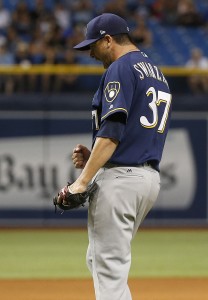Like most free agents, Mike Moustakas has been met with an unexpectedly slow market this offseason, writes ESPN’s Buster Olney. Zack Cozart’s willingness to move from shortstop to third base and the potential presence of names like Manny Machado, Evan Longoria and Josh Donaldson on the trade market have all complicated matters for Moustakas, who entered the winter as the consensus top third baseman available in free agency. Olney writes that some MLB evaluators have questioned how well Moustakas’ body will hold up into his 30s, which represents another potential stalling point in his market. Olney speculates about the possibility of Moustakas ultimately settling for a one-year deal and reentering free agency next winter, noting that the Orioles, Yankees and Cardinals would all represent very logical landing spots on a short-term pact. Of course, it remains to be seen whether he’d be amenable to such an arrangement; the majority of top position players remain unsigned, after all, and agent Scott Boras has a history of lengthy trips through free agency for some of his clients.
Some more notes on the free-agent market…
- Olney also reports that the Giants are among the clubs considering righty Trevor Cahill for a rotation spot (Twitter link). Cahill, 30 in March, was terrific early in the year before a shoulder injury torpedoed his season. Through his first 41 1/3 innings with the Padres, Cahill logged a 3.27 ERA with 11.1 K/9, 3.7 BB/9, 0.65 HR/9 and a 60.2 percent ground-ball rate. Upon returning from that injury, however, he was rocked for a 6.54 ERA In 42 2/3 frames between the Padres and Royals. Cahill’s newfound ability to miss bats completely evaporated after being activated from the DL (7.6 K/9), and he was unable to find the strike zone with any consistency (5.9 BB/9).
- The Mets have indeed “reached out” to Adrian Gonzalez, tweets Olney. (Olney and others had previously suggested the Mets were likely to explore the possibility.) New York’s level of interest isn’t known, but they have a considerably more intriguing option in-house in the form of Dominic Smith, and the market bears a number of considerably more appealing veterans (all of whom, albeit, are more expensive). The 35-year-old Gonzalez could be had for just the league minimum, as the Braves are on the hook for the remainder of his salary, but he’s coming off a season that was ruined by back injuries and saw him post an unsightly .242/.287/.355 slash line in 252 plate appearances.
- The Dodgers have some interest in Japanes closer Yoshihisa Hirano, Tim Brown of Yahoo Sports tweeted recently. The 33-year-old Hirano has starred for NPB’s Orix Buffaloes for quite some time, amassing 143 saves with a 2.62 ERA, 9.4 K/9 and 2.4 BB/9 through 271 1/3 innings from 2013-17. Hirano, who will turn 34 next spring, has enough professional experience that he’s exempt from the posting system and is able to sign a Major League deal without going through the posting system. He’s also been linked to the Cardinals and Tigers this winter.
- ESPN’s Jerry Crasnick reports that the Indians aren’t operating under the same capacity that they did last offseason when they surprised everyone by signing Edwin Encarnacion (Twitter links). Cleveland is looking at lower-profile first base options to replace Carlos Santana, with Crasnick listing the likes of Lucas Duda, Matt Adams, Logan Morrison and Yonder Alonso as possibilities rather than Eric Hosmer. (Speculatively, I’d imagine that even Morrison and Alonso could be beyond Cleveland’s comfort zone.) Dealing Jason Kipnis and the remaining $30.5MM on his contract (2018-19) would open up some additional funds for the team to reallocate to a first baseman or additional bullpen help, Crasnick notes.
- Darren Wolfson of 1500 ESPN touched on a number of Twins-related issues in his most recent podcast (audio link, Twins talk beginning at the 3:30 mark). Minnesota was in on Drew Smyly until the end, per Wolfson, before Smyly chose to sign with the Cubs. Minnesota gave an identical two-year, $10MM guarantee to Michael Pineda instead, and they have some interest in working out a two-year agreement with injured reliever Trevor Rosenthal as well. Minnesota has shown no inclination to spent upwards of $9MM on multi-year deals for relievers and doesn’t love the idea of going to six years on Yu Darvish, though the team does maintain strong interest in the righty. Wolfson notes that the trade market could be an avenue for improving the ’pen and/or rotation.

